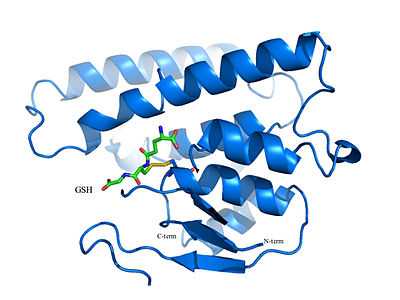Bacterial glutathione transferase
From Wikipedia, the free encyclopedia

Beta class glutathione transferase structure from Proteus mirabilis (PDB: 1PMT).[1]
Bacterial glutathione transferases (GSTs; EC 2.5.1.18) are part of a superfamily of enzymes that play a crucial role in cellular detoxification.[2][3][4] The primary role of GSTs is to catalyse the conjugation of glutathione (GSH) with the electrophilic centers of a wide variety of molecules.[5]
GSTs are widely distributed in aerobic bacteria and are classified into several classes. GSTs are not detected in anaerobic bacteria or archaea.[6]
In bacteria, GSTs are involved in a variety of distinct processes such as biotransformation of toxic compounds, protection against several stresses and antibacterial drug resistance.[7][8][9][10][11]
See also
References
- ↑ Rossjohn J, Polekhina G, Feil SC, Allocati N, Masulli M, Di Ilio C, Parker MW (1998) A mixed disulfide bond in bacterial glutathione transferase: functional and evolutionary implications. Structure 6 721–734.
- ↑ Hayes JD, Flanagan JU, Jowsey IR (2005). "Glutathione transferases". Annual Review of Pharmacology and Toxicology 45: 51–88. doi:10.1146/annurev.pharmtox.45.120403.095857. PMID 15822171.
- ↑ Sheehan D, Meade G, Foley VM, Dowd CA (November 2001). "Structure, function and evolution of glutathione transferases: implications for classification of non-mammalian members of an ancient enzyme superfamily". The Biochemical Journal 360 (1): 1–16. doi:10.1042/0264-6021:3600001. PMC 1222196. PMID 11695986.
- ↑ Oakley AJ (December 2005). "Glutathione transferases: new functions". Current Opinion in Structural Biology 15 (6): 716–23. doi:10.1016/j.sbi.2005.10.005. PMID 16263269.
- ↑ Oakley A (May 2011). "Glutathione transferases: a structural perspective". Drug Metab. Rev. 43 (2): 138–51. doi:10.3109/03602532.2011.558093. PMID 21428697.
- ↑ Allocati N, Federici L, Masulli M, Di Ilio C (January 2009). "Glutathione transferases in bacteria". The FEBS Journal 276 (1): 58–75. doi:10.1111/j.1742-4658.2008.06743.x. PMID 19016852.
- ↑ La Roche SD, Leisinger T (January 1990). "Sequence analysis and expression of the bacterial dichloromethane dehalogenase structural gene, a member of the glutathione S-transferase supergene family". Journal of Bacteriology 172 (1): 164–71. PMC 208414. PMID 2104602.
- ↑ Masai E, Katayama Y, Kubota S, Kawai S, Yamasaki M, Morohoshi N (May 1993). "A bacterial enzyme degrading the model lignin compound beta-etherase is a member of the glutathione-S-transferase superfamily". FEBS Letters 323 (1-2): 135–40. doi:10.1016/0014-5793(93)81465-C. PMID 8495726.
- ↑ Favaloro B, Tamburro A, Trofino MA, Bologna L, Rotilio D, Heipieper HJ (March 2000). "Modulation of the glutathione S-transferase in Ochrobactrum anthropi: function of xenobiotic substrates and other forms of stress". The Biochemical Journal 346 (2): 553–9. doi:10.1042/0264-6021:3460553. PMC 1220885. PMID 10677378.
- ↑ Orser CS, Dutton J, Lange C, Jablonski P, Xun L, Hargis M (May 1993). "Characterization of a Flavobacterium glutathione S-transferase gene involved reductive dechlorination". Journal of Bacteriology 175 (9): 2640–4. PMC 204566. PMID 8478329.
- ↑ Rigsby RE, Brown DW, Dawson E, Lybrand TP, Armstrong RN (August 2007). "A model for glutathione binding and activation in the fosfomycin resistance protein, FosA". Archives of Biochemistry and Biophysics 464 (2): 277–83. doi:10.1016/j.abb.2007.04.035. PMC 2709490. PMID 17537395.
External links
This article is issued from Wikipedia. The text is available under the Creative Commons Attribution/Share Alike; additional terms may apply for the media files.